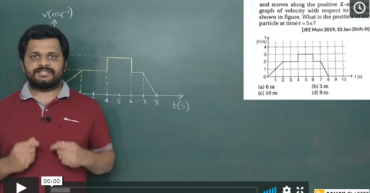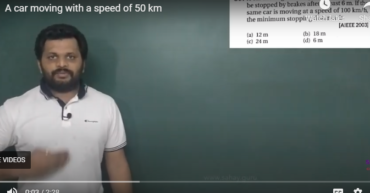Chapter 2 – Kinematics
Sahay Sir > Question Answers > JEE Mains Physics 2002-2019 Solved Video Solutions > Chapter 2 - Kinematics
The trajectory of a projectile near the surface of the earth is given as y = 2x – 9x^2 . If it were launched at an angle θ0 with speed v0 then g = 10 ms^–2
23
Oct
The trajectory of a projectile near the surface of the earth is given as y = 2x – 9x^2 . If it were launched at an angle θ0 with speed v0 then g = 10 ms^–2 The trajectory of a projectile near the surface of the earth is given as y = 2x – 9x^2 [...]
A shell is fired from a fixed artillery gun with an initial speed u such that it hits the target on the ground at a distance R from it. If t1 and t2 , are the values of the time taken by it to hit the target in two possible ways, the product t1t2 is:
23
Oct
A shell is fired from a fixed artillery gun with an initial speed u such that it hits the target on the ground at a distance R from it. If t1 and t2 , are the values of the time taken by it to hit the target in two possible ways, the product t1t2 is: [...]
A plane is inclined at an angle α = 30° with respect to the horizontal. A particle is projected with a speed u = 2 ms^–1 from the base of the plane making an angle θ = 15° with respect to the plane as shown in the figure. the distance from the base at which the particle hits the plane is close to :
23
Oct
A plane is inclined at an angle α = 30° with respect to the horizontal. A particle is projected with a speed u = 2 ms^–1 from the base of the plane making an angle θ = 15° with respect to the plane as shown in the figure. the distance from the base at which [...]
The position vector of a particle changes with time according to the relation r→(t)=15t^2iˆ+(4−20t^2)jˆ What is the magnitude of the acceleration (in ms^-2)?
23
Oct
The position vector of a particle changes with time according to the relation r→(t)=15t^2iˆ+(4−20t^2)jˆ What is the magnitude of the acceleration (in ms^-2)? The position vector of a particle changes with time according to the relation r→(t)=15t^2iˆ+(4−20t^2)jˆ What is the magnitude of the acceleration (in ms^-2)? October 23, 2020 Category: Chapter 2 - Kinematics , [...]
The stream of a river is flowing with a speed of 2km/h. A swimmer can swim at a speed of 4km/h. What should be the direction of the swimmer with respect to the flow of the river to cross the river straight?
23
Oct
The stream of a river is flowing with a speed of 2km/h. A swimmer can swim at a speed of 4km/h. What should be the direction of the swimmer with respect to the flow of the river to cross the river straight? find the values of (2a1+3a2)(3a1-2a2) is Given |a1|=3 and |A2|=5 and |a1+a2|=5 October [...]
Given |a1|=3 and |A2|=5 and |a1+a2|=5, find the values of (2a1+3a2)(3a1-2a2) is
23
Oct
Given |a1|=3 and |A2|=5 and |a1+a2|=5, find the values of (2a1+3a2)(3a1-2a2) is find the values of (2a1+3a2)(3a1-2a2) is Given |a1|=3 and |A2|=5 and |a1+a2|=5 October 23, 2020 Category: Chapter 2 - Kinematics , JEE Mains Physics 2002-2019 Solved Video Solutions ,
Ship A is sailing towards north-east with velocity vector v = 30 i + 50 j km/hr where i points east and j north. Ship B is at a distance of 80 km east and 150 km north of Ship A and is sailing towards west at 10 km/hr. A will be at minimum distance from B in
23
Oct
Ship A is sailing towards north-east with velocity vector v = 30 i + 50 j km/hr where i points east and j north. Ship B is at a distance of 80 km east and 150 km north of Ship A and is sailing towards west at 10 km/hr. A will be at minimum distance [...]
A particle starts from the origin at time t = 0 and moves along the positive x – axis. The graph of velocity with respect to time is shown in figure. What is the position of the particle at time t = 5s?
16
Sep
A particle starts from the origin at time t = 0 and moves along the positive x – axis. The graph of velocity with respect to time is shown in figure. What is the position of the particle at time t = 5s? A river is flowing from west to east at a speed of [...]
A car moving with a speed of 50 km h^−1 can be stopped by brakes after atleast 6 m. If the same car is moving at a speed of 100 km h^−1 the minimum stopping distance is :
09
Sep
A car moving with a speed of 50 km h^−1 can be stopped by brakes after atleast 6 m. If the same car is moving at a speed of 100 km h^−1 the minimum stopping distance is : A car moving with a speed of 50 km h^−1 can be stopped by brakes after atleast [...]
An automobile travelling with speed of 60 km/h, can brake to stop within a distance of 20 m. If the car is going twice as fast, i.e. 120 km/h, the stopping distance will be:
09
Sep
An automobile travelling with speed of 60 km/h, can brake to stop within a distance of 20 m. If the car is going twice as fast, i.e. 120 km/h, the stopping distance will be: An automobile travelling with speed of 60 km/h can brake to stop within a distance of 20 m. If the car [...]


